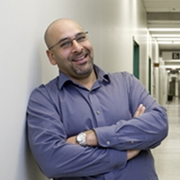
The goal of Dr. Bains’s lab is to understand how physiological and behavioral challenges lead to long-term changes in neural circuitry. The Lab focuses on neurons that coordinate an organism's response to stress, with a particular interest in clarifying how the molecules released at the onset of a stressful stimulus leave a lasting imprint on how ‘stress-relevant' circuitry functions. Within this context, the Bains lab conduct experiments that will allow it to understand the fundamental rules that govern cell to cell communication within the hypothalamus and elucidate the molecular machinery that contributes to changes in synaptic function which, in turn, may be critical for changing network output.
The Lab is currently exploring three lines of investigation:
The Bains lab uses a number of experimental techiques to answer the above questions. These include, but are not limited to: patch clamp recordings from neurons in brain slices for the measurement of excitatory and inhibitory synaptic currents; UV laser uncaging of bioactive molecules; immunohistochemistry for the labeling of receptors and neuronal subpopulations.
Source: http://www.hbi.ucalgary.ca/members/bains